Archive for August, 2009
KOR Hydration Vessel in New Colors
We’ve splashed some new color into our reusable water bottle collection. Check out the new KOR Hydration Vessels that we recently released – Sawgrass and Orchid Pink. If you do your part to stop the 10’s of millions of disposable water bottles going into our trash every year, well, that would be just keen.
Urban Farming And Repurposed Buildings
Per usual, another awesome and insightful article over at Treehugger.com. Check out the ideas for farming in your urban area and re-claiming un-used urban space to help people out and revitalize your city.
“…located a mile away from my former home, one of the tenants, Seattle Tilth, inspires and educates people to garden organically and consider urban chicken coops and beehives. My neighbors upstairs turned half our yard into a garden. Last week it held a workshop in Herbal Tea Gardening and on the 23rd it gives one on Composting for Apartment Dwellers. Take a look at the…” READ MORE!
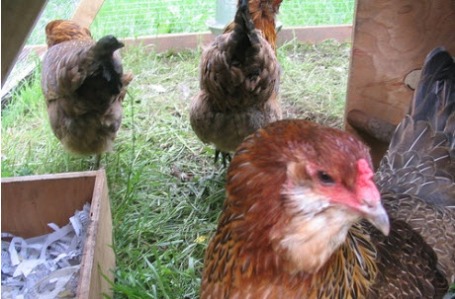
What Does the Recycling Symbol Mean Pt. 6 – The No. 4
The recycling symbol number 4 is telling you that the plastic is made of low-density polyethylene (LDPE) is a thermoplastic made from petroleum (BOO!). It was the first grade of polyethylene, produced in 1933 by Imperial Chemical Industries (ICI) using a high pressure process via free radical polymerisation [1]. Its manufacture employs the same method today. LDPE is supposedly commonly recycled, but we can’t find a citation indicating any proof or research done to substantiate the claim.

LDPE is widely used for manufacturing various containers, dispensing bottles, wash bottles, tubing, plastic bags for computer components, and various molded laboratory equipment. Its most common use is in plastic bags. Other products made from it include:
* Trays & general purpose containers
* Food storage and laboratory containers
* Corrosion-resistant work surfaces
* Parts that need to be weldable and machinable
* Parts that require flexibility, for which it serves very well
* Very soft and pliable parts
* Six-pack soda can rings
* Extrusion coating on paperboard and aluminum laminated for beverage cartons.
* Computer components, such as hard drives, screen cards and disk-drives.
* Playground Slides
* Plastic Bags
Remember, no matter what the symbol (which coaxes most people into feeling that the product is safe for the environment because it can be recycled), there are many more factors that play into if this plastic will ever be recycled rather than wasted. Your local government’s recycling laws are the biggest obstacle to plastics actually being recycled (go find yours at whatever the name of your town or state it with a .gov attached rather than a .com or .net).
The best thing you can do is use products that are made with the environment and your health in mind. Check out our extensive supply of reusable water bottles and reusable shopping bags at ecosumo.com and help us fight The Disposable Water Bottle Beast.
The Good Guide to Reducing Your Water Use, Part 2: Outdoors
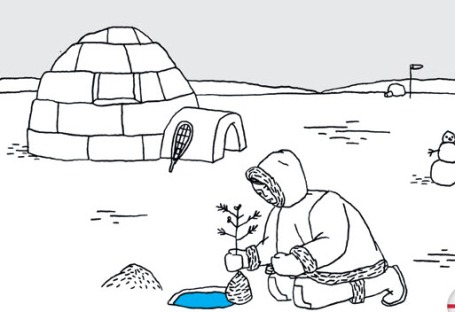
2A: Lose the Lawn, Water Hogs
Potential water savings: up to 150 gallons per day, per household.
There are much better ways to decorate or shade your turf, and it largely depends on where you live. Here’s a primer.
Planting appropriately is the best way to conserve water and not kill your plants. Much of the Western United States, for example, is built on or near deserts. That means that drought-tolerant planting is key. In the Midwest’s colder climes, you should opt for hardier varieties of flowers and shrubs. Getting creative can save thousands of gallons per year on outside use.
Since 1960, the United States Department of Agriculture has published something called the hardiness zone map—a road map for planting locally. But it doesn’t offer other variables like rainfall, the number of sunny days, and soil conditions. With that in mind, we’ve created our own map of the country, which shows you what to plant and what not to plant, while using the least amount of water.
 Climate Because rainfall in Brooklyn, New York, for example, averages a healthy 44 inches per year, with a few tweaks, storm runoff and water recycling can take care of all your watering needs.
Climate Because rainfall in Brooklyn, New York, for example, averages a healthy 44 inches per year, with a few tweaks, storm runoff and water recycling can take care of all your watering needs.
Local plants Flowering dogwood, highbush blueberry, wild leek, birdfoot violet
Smart landscaping choice Pennsylvania bluestone. A layered sandstone, it originates in the Northeast and is pretty to look at. Best of all? No watering needed.
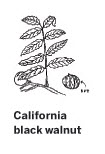 Climate Sacramento, California, has a Mediterranean climate with winters that are cool and wet and summers that are hot and dry. As in much of the west, water is scarce, so a synthetic lawn would save water.
Climate Sacramento, California, has a Mediterranean climate with winters that are cool and wet and summers that are hot and dry. As in much of the west, water is scarce, so a synthetic lawn would save water.
Local plants California wild grape, elderberry, California black walnut, coyote brush
Smart landscaping choice An ecologically sound synthetic lawn—seriously, it’s that bad. If you can’t live without real grass go with Eco Lawn, a brand of drought-resistant grasses that require very little watering.
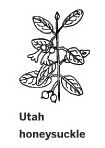 Climate Boise, Idaho, is a city of extremes: hot and dry 90-degree summers and cold snowy winters. As in other nearby cities, rainfall is scarce, so using local plants accustomed to the climate is crucial.
Climate Boise, Idaho, is a city of extremes: hot and dry 90-degree summers and cold snowy winters. As in other nearby cities, rainfall is scarce, so using local plants accustomed to the climate is crucial.
Local plants Western juniper, Utah honeysuckle, prairie junegrass, Rocky Mountain maple
Smart landscaping choice Recycled rubber pavers. A sustainable softscaping option, rubber flooring is easy to install, low-impact, and the recycling diverts it from landfills.
 Climate As the southernmost city in the continental United States, Key West, Florida, is essentially in the Caribbean, and the same climatic limitations apply. The weather is temperate all year long, but there are dry and wet seasons, and taking advantage of the former is important to keeping your environs thriving.
Climate As the southernmost city in the continental United States, Key West, Florida, is essentially in the Caribbean, and the same climatic limitations apply. The weather is temperate all year long, but there are dry and wet seasons, and taking advantage of the former is important to keeping your environs thriving.
Local plants Coconut palm, bellflower, Key lime, saw palmetto
Smart landscaping choice Seashell mulch. The mulch functions as a barrier to lock in moisture and prevent evaporation for the dryer season and help prevent excess weed growth.
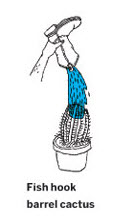 Climate Tucson, Arizona, which lies in the Sonoran Desert, suffers from serious water issues. It rains during the month-long monsoon season, but not much during the rest of the year. More than half the local golf courses use recycled water.
Climate Tucson, Arizona, which lies in the Sonoran Desert, suffers from serious water issues. It rains during the month-long monsoon season, but not much during the rest of the year. More than half the local golf courses use recycled water.
Local plants Fishhook barrel cactus, desert ironwood, Arizona poppy, Parry’s agave
Smart landscaping choice Permeable concrete pavers. Rain scarcity makes lawns unsustainable without a ton of watering, and permeable pavers send water into the landscape instead of into sewers.
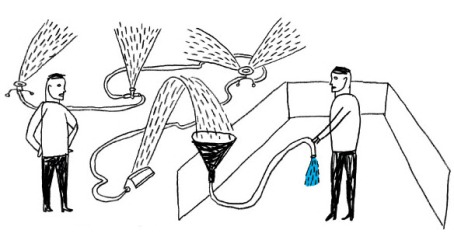 2B: Garden Grows
2B: Garden Grows
Potential water savings: more than 40 gallons, per household.
A few ways to water your plants and grass without going broke.
First, the good news: There are more tools than ever—like downspouts and 100-percent-recycled plastic cisterns—to harvest every precious drop of water. Now the bad: Not everyone can afford these newfangled products. But don’t fret. You don’t have to be MacGyver to rig up a low-cost alternative.
A Plant-watering Buy
Watering plants too much is as damaging as watering them too little, especially with dwindling water sources. One option is to buy stackable planters by Stack and Grow, which drain water from plant to plant, making sure each one is adequately quenched. It’s also expandable. Just stack up to four additional modules on top of the main unit. They cost around $40 each, and are very nice to look at.
An A/C Plant Watering Hack
Air conditioners drip a little while they’re running, which could mean wasted water and damage to your building’s façade. All A/C window units have a drain hole, so get a basic funnel for a buck at the hardware store, and tape it to the drain. Then, get thin rubber tubing for a few dollars, and tape that to the funnel tip. Run the tube down and place it in an idiot-proof plant. Mint is a great choice. Now you’re watering your plant for free.
A Rain-barrel Buy
For about $100, you can get a Smith & Hawken collapsible rain barrel, which retains up to 35 gallons of water, folds flat for under-bed storage in the off season, and is small enough to fit on a New York terrace. There’s no excuse not to recycle rainwater.
A Rain-barrel Hack
Rain is basically free water. It’s not the cleanest, thanks to pollution, so you wouldn’t want to drink it, but it’s perfectly useable for all your outdoor water needs. If you can get your hands on an old drum, great. If not, any 5-gallon bucket will do. Place the bucket underneath the downspout of your home’s gutter. If you’re a renter, or not near the gutter, just put it anywhere outside. After a nice rain, remove the bucket and save it to water your plants and yard later.
Original article can be found HERE. Our great thanks to the authors Adam Matthews , Siobhan O’Connor
The Good Guide to Reducing Your Water Waste, Part I: The Bathroom
We found a magnificent article written by Siobhan O’Connor , Adam Matthew on July 28, 2009 and just new we had to help them spread the word. The article is amazingly informative and creative about how to reduce your water usage in practical ways. It’s a large article so we’ll be syndicating it in several parts. You can also go to the original HERE.
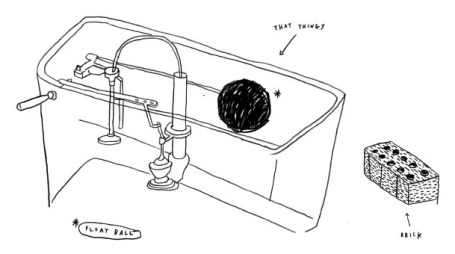
1A: A (Clean) Toilet Hack
Potential water savings: Up to 18 gallons per day, per person.
How to easily reduce the water wasted by every flush.
Toilets waste tons of water every year. When you flush, that’s about five or six gallons right there if you have a conventional toilet, and on average we each flush six times a day. Thankfully, there are now all sorts of products to lessen gallons per flush. There are low-cost add-ons like the Toilet Tummy or the British-made Hippo the Water Saver. You can also purchase a dual-flush toilet, which can save up to five gallons per flush by offering one kind of flush for each bodily function. But the lower-tech and less-well-heeled among us might want to try this easy and free hack.
Get Started
1. Remove the lid from your toilet.
2. Observe the black floating ball. This thing determines the water level in your toilet.
3. Reach into the toilet tank and grab the thin metal rod attached to the black floating ball.
4. Bend the rod downward just a little. It won’t break easily, but be ginger, yeah?
5. Be an optimist. Your tank is now half full.
Idiot-proof Version
Put a brick or two—or other heavy, noncorrosive objects—in the tank. That will let the toilet think it has more water in it than it does, and reduce the water used per flush.

1B: A (Dirty) Toilet Hack
Potential water savings: Up to 36 gallons per day, per person.
How to forgo water altogether, without a flush.
Most of the readers of the Urban Homestead blog, a guide to self-reliant city living, buy in to the lifestyle strategies of authors Kelly Coyne and Erik Knutzen. Except one: composting your own feces. “It horrifies most people,” Knutzen admits. For Knutzen, an adherent of “humanure” guru Joseph Jenkins, the practice makes perfect sense. “Nitrogen makes plants grow,” he says. “You flush it down the toilet and create pollution in our riverways. So you are taking two valuable things and making trash.” Instead, Knutzen suggests following these five steps to composting your own solids.
Get Started
1. Get a five-gallon bucket and line the bottom with sawdust. Attach a lidded toilet seat.
2. Do your business and cover it with sawdust. Repeat. Empty once or twice a week into a 55-gallon composter out back.
3. After each waste dump, add leaf litter, coconut husks, or finely shredded newspaper over the waste into the container. “You’re basically making crap lasagna,” says Knutzen.
4. Keep it as moist as a wrung-out mop. You want it to get hot—120 degrees Fahrenheit is ideal, monitored with a long thermometer. Adding earth worms are good, too.
5. Let it age for a year. Fertilize plants.
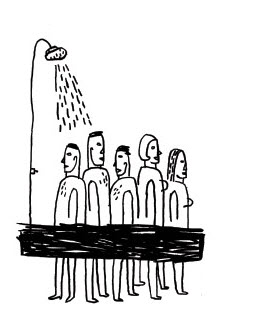 1C: How To Bathe
1C: How To Bathe
Potential water savings: up to 134 gallons per day, per household
Settling the shower versus bath debate.
You’ve probably heard that showers use less water than baths. This is true—or can be—but it depends on a few things. Most conventional bathtubs hold 60 gallons of water. The average shower head spews between 2.5 and 4 gallons per minute, depending on whether it was made before or after 1992. Even if you have a higher-flow shower head, you have to shower for 15 minutes before you’re at bath levels—24 minutes if your head is newer. The average American shower length is under eight minutes. Of course, if you fill your tub halfway and shave in there without water running, you could theoretically be using less water than showering, so it’s not cut and dried, but the evidence seems to heavily favor showering. Also, for $40, you can get a one-gallon-per-minute shower head by Bricor, and for $10 you can get a 1.2-gallons-per minute Real Goods shower head—with a pause button to use while lathering. At those rates, you might feel justified in taking the occasional half-hour shower.
Other DIY Bathroom Options
Let It Mellow
Everyone’s been to someone’s hippie parents’ country house where you’re instructed to let it mellow if it’s yellow. It’s an unpleasant concept, but by now you know that unless you have a fancy new low-flow or dual-flush toilet, the toilet is your home’s biggest water suck—it accounts for almost 30 percent of your daily water use. Since the average person urinates six times a day, may we suggest you flush every other time?
Savings Upwards of 18 gallons a day
Keep a Bucket Handy
You can lose about four gallons per minute when you run the bath, so consider the loss that happens as you run the water to get it to the right temperature. Keep a bucket handy in the bathroom and collect the water as it falls for plant watering and an additional flush. When enough volume is poured into the toilet, it essentially flushes itself, as the water level in a toilet remains constant (in other words, a flush is just water being poured into the toilet from the tank; you’d be doing it with a bucket instead).
Savings Up to 10 gallons a day
Navy Showers
As with most things imported from the military, it’s simple: Get wet, turn the water off, soap up, rinse off. You’re done in as little as three minutes, and you’ve only used a few gallons of water. Conserving water isn’t always comfortable, but it’s something you can get used to, like anything else. Think of our men in uniform.
Savings Up to 50 gallons over a regular 10-minute shower
Reuse Your Bathwater
Nearly 60 percent of Japanese people reuse their bath water. Some filter it and use it for other purposes that require clean water (washing dishes, etc.), others use it to water their plants. You know by now you shouldn’t be taking baths (from a water-economy perspective, we mean), but if you do, make use of that water and don’t take a shower after. If you do, you’re using more than half a day’s worth of total water for one bath.
Savings Up to 50 gallons per bath
Pee in the Shower
You can save one flush a day by urinating in the shower—two if you shower more than once a day. Sure it’s gross, but unless you have an infection, your urine is sterile and nontoxic, and it washes down with your shampoo and soap anyway. An unscientific poll by Glamour magazine recently found that 75 percent of respondents do pee in the shower.
Savings Up to 6 gallons of water a day
A More Creative Way to ‘Dispose’ of Disposable Water Bottles
Of course, we recommend that you don’t even use disposable water bottles and fuel the Disposable Water Bottle Beast. However, we are realistic – sometimes you don’t have a choice and water is one of those things humans can’t put off for too long. And, sometimes your town’s recycling facilities are just a joke.
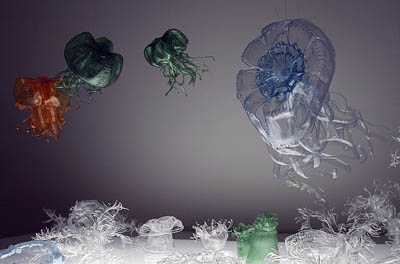
So how about Art? Check out this blog post from Blogher.com where she highlights artists who recycle disposable water bottles into jewelry, eco-art and home accessories. Pretty amazing stuff.
For reusable water bottle art, check us out at ecosumo.com. The artist’s will still have plenty of material to work with! Peace…ecosumo
What a great TWIST!
We have a new member to the Ecosumo family of products – the TWIST line. Twist is a focused line of products bent on helping you clean up everything from the walls to the floor to the dishes. And we’re going to say this now – we never even thought that a sponge or dishtowel could look stylish…but these guys pulled it off.

Check out there Loofah Scrubby. The Loofah Scrubby works on all your simple cleaning needs, but its made extra tough to handle the hard to clean pans after a cheesy dish or a burned casserole (not that you’re not a great cook…it just happens sometimes). It’s got sponge on the inside, and super scrubby loofah on the outside. It’s also all-natural and dye free.
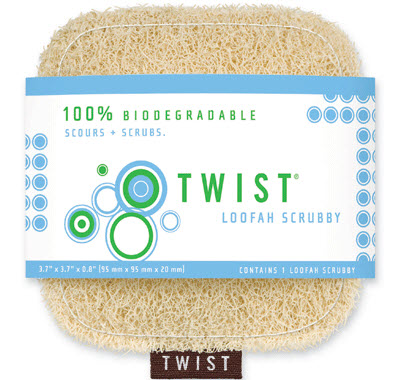
Or get Naked while you clean with the Naked Sponge. By Naked we mean without chemicals, colors, and any of the adulterated stuff found in those ugly old yellow and green sponges. And there are 3 sizes of Naked-ness to have ready to combat your dirt.
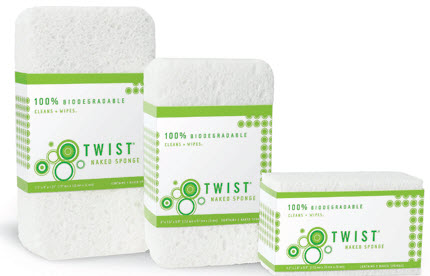
And don’t neglect the Dish Dumpling. Described as a “nugget of sponge power”, this agave-wrapped cutie-pie is dye-free and biodegradable. Seriously, its so adorable that stains won’t fight back (puppy eyes just met their match.)
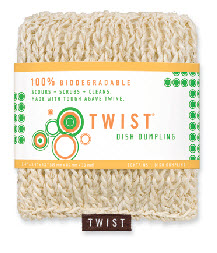
Check out all the new sponges and cleaning items at the ecosumo site.
And here’s little tid-bit – don’t throw away the packaging. In an effort to decrease waste, Twist’s pacakging can be turned into bird-feeders by following the instructions on the inside. Kudos to Twist for imaginative environmentalism!
Peace…Ecosumo




Recent Comments